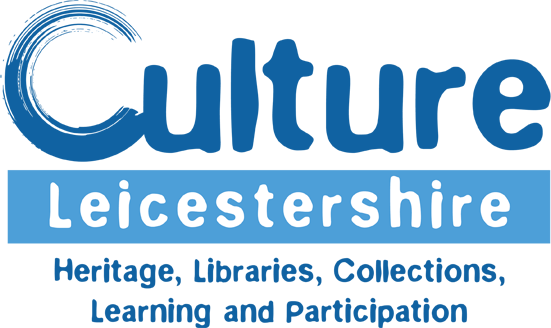BACA
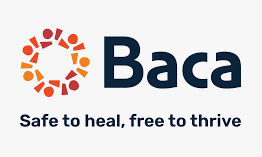 The jewellery on display in the Baca case in the exhibition and the stories that go with it have been shared by young people who have been forced to flee their home country, because of war, persecution, or trafficking.
The jewellery on display in the Baca case in the exhibition and the stories that go with it have been shared by young people who have been forced to flee their home country, because of war, persecution, or trafficking.
Baca Charity, provides a safe home, education and therapeutic care that enables young people to fulfil their potential and become thriving members of the community. For more information on how you can get involved go to www.bacacharity.org.uk .
“Much of our valuable things are lost or broken because we have left everything behind when we left our families and our countries, but we still remember the stories. Now we are making new stories for our future.”
– Quote by a young asylum seeker separated from their family.
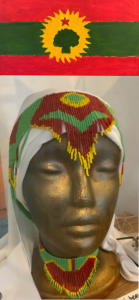
Handmade Headdress and Necklace in the Ethiopian Oromo Tradition
“For me this is really special because I designed it with the colours of my Oromo flag. This is the flag for my people in Ethiopia. It symbolises freedom and identity. If you fly this flag in Ethiopia it can be very dangerous and you can go to prison or even worse because we are fighting for independence. That is why I designed this headdress and necklace as a protest. Usually we would wear traditional jewellery like this in our culture when we get married or there is a BIG celebration or very special occasion.”
This story was told by a young lady from Ethiopia, who also made the headdress and necklace.
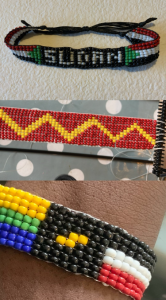
Flags and Beads
“Our culture and language give us a strong sense of identity. Jewellery is often a way that we share these things with others. If you have had to leave your own country because of war, disaster and danger, mementos of culture and tradition become even more important! Making bead body decorations and jewellery is a familiar traditional craft in Sudan and lots of cultures in Africa. It has been fun to make bead bracelets which remind young people of home, some with the colours of their flags. These can be worn as a symbol of where they are from and who they are.”
Clare Miles, Art Therapist, BACA Charity
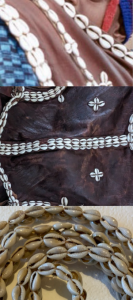
Cowrie Shell Necklace
Cowrie shells are sought after decorations for jewellery.
“In Tigray, Ethiopia some people use them for decorating baby carriers called ‘Dewelo’. The sound of the shells rubbing together is very nice and soothing and is good for helping babies to relax and go to sleep and they look really pretty as a lovely decoration too”
Shared by a young man from Tigray
“The necklace in this exhibition actually comes from Kenya, it was a special memento and reminder of a place and of valuable friendship.”
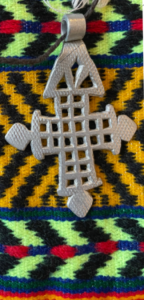
Coptic Orthodox Cross
“This cross was given to me by the Priest when I was baptised in the Christian Orthodox Church at 80 days old. After this I kept it on all the time, it came all the way with me on my journey from Eritrea. In Libya many Orthodox Christians are killed for their faith because they will not take off their cross. It is very bad. wearing a cross is so special for me, it is like my heart beating. I always wear a cross and never take it off because it is a sign of my faith that Jesus died for me. The strong on this cross was broken as it was very old, I have another cross I am wearing at the moment but wanted you to know my story and then I will mend this necklace and wear it again.”
Cross and story shared by an Eritrean young lady who is an Orthodox Christian
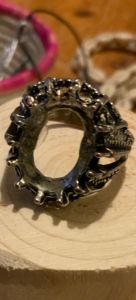
Broken Pieces
“My ring is broken and my heart is broken”
“My ring was given to me by my mother in Iran but I was in danger and I had to leave her. I wore my ring and kept it safe on my journey. When I came to England it broke and I was so sad because I did not have anything else that my mother gave me. I felt like everything was broken. Even though it is broken it is still so important for me. I do not know where my mother is now but my broken ring reminds me of her and I hope I will see her again one day.”
Shared by a Kurdish young man from Iran
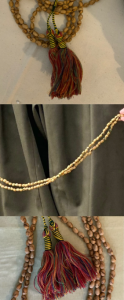
Kurdish Tisbeh – Muslim prayer beads
“This Tisbeh is very special not only because it helps me to pray by feeling each bead, but also because I use it to help me relax, I love the sound of the beads when they rub together, I love the feel of the beads in my hand, so smooth and warm. I like to wear it with my traditional dress. My Uncle would go into the mountains in Iran and collect the seeds of a very a special tree that was hard to find. He would make beautiful Tisbeh. A Tisbeh can cost a lot of money but it is even more valuable when it is given by someone who has made it as a gift and a sign of friendship. My Tisbeh reminds me of my Uncle and the people that I love. It is very important to me and I would never want to lose it. I think I should attach a ‘gps’ to it!”
Tisbeh and story shared by a Kurdish young man from Iran
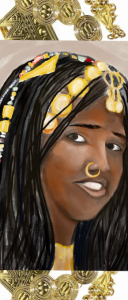
Eritrea and our Beautiful Traditional Jewellery and Decoration
“The women in my culture are very beautiful! My mother used to wear beautiful gold jewellery in her hair, face and neck. We lived in a refugee camp in Sudan and she would still wear her gold nose ring. When I was a child I would sometimes touch it! If my mother was asleep and I wanted her to wake up I used to go and start to play with it and she would wake up and tell me that I was always fiddling with her things!”
“Jewellery can also be on things we use and my mother also had these beautiful tools and decorations for the house.”
Shared by a young man from Eritrea
